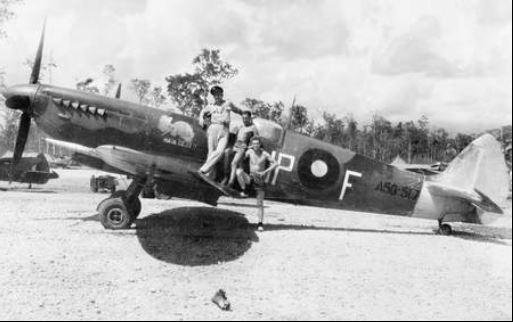No. 79 Squadron RAAF
From Our Contribution
 79 Squadron pilot wih his aircraft at Morotai in September 1945 | |
Brief History
No. 79 Squadron was formed at RAAF Station Laverton in Victoria on 26 Apr 1943. The squadron's intended role was to use Spitfire Vc fighters to provide 'high cover' escort for the RAAF's P-40 Kittyhawk-equipped units which were engaging Japanese forces in the New Guinea Campaign. This requirement was considered so urgent, that No. 79 Squadron receive priority for the RAAF's limited stock of Spitfires. The squadron moved to Wooloomanata Aerodrome several days after it was formed, and received its first Spitfires on 3 May. While at Wooloomanata No. 79 Squadron undertook training exercises to prepare for combat.
No. 79 Squadron began moving to Goodenough Island off the north coast of Papua in mid-May 1943. Its advance party departed on 17 May, followed by the pilots on 4 June. The main body of ground crew sailed from Sydney on 7 June. During the unit's transit to Goodenough Island, No. 79 Squadron Spitfires were scrambled from Gurney Airfield at Milne Bay on several occasions between 19 and 25 June to intercept Japanese reconnaissance aircraft.
The squadron completed its movement to Goodenough Island on 26 Jun 1943 and began flying air defence sorties from there. It did not intercept any Japanese aircraft while operating from this base. The squadron moved to Kiriwina Airfield between 9 and 18 August, from where it operated alongside the P-40 Kittyhawk-equipped No. 76 Squadron. They conducted patrols in support of United States Army Air Forces raids on Rabaul. The squadron claimed its first victory in 31 Oct 1943.
After a period of training, No. 79 Squadron flew its first sweep over Japanese-held territory on 27 Nov 1943 when eight Spitfires were dispatched to Gasmata on New Britain. During January and February 1944 the squadron conducted offensive sweeps over New Britain, strafed Japanese positions and escorted Allied bombers. On 17 Jan 1944, eight No. 79 Squadron Spitfires took part in an attack against a Japanese camp near Lindenhafen which involved 73 Australian aircraft, the largest RAAF operation of the war up to that time.
In early 1944 they supported the US Army's Admiralty Islands campaign with a move to Momote Airstrip on Los Negros Island in March 1944. No. 79 Squadron was operational there with 24 aircraft, flying ground attack sorties in support of US troops until Japanese resistance ceased. By the end of April, No. 79 Squadron's main role was to escort Allied shipping. Due to a shortage of aircraft the squadron's flying activities were limited to training sorties between August and October, and aircraft availability continued to be a problem until late November 1944. On 24 Nov 1944 the squadron was released from operations ahead of moving to Darwin to be re-equipped with more modern Mark VIII Spitfires.
They arrived at Sattler Airfield south of Darwin on 12 Jan 1945 and received their new aircraft shortly afterwards. It began to move to Morotai in the Netherlands East Indies (NEI) on 6 Feb 1045 and became operational there at the end of March. The squadron conducted ground attack sorties against Japanese positions on nearby islands until the end of the war and also became responsible for Morotai's air defence from 28 May. Several Spitfires were shot down by anti-aircraft fire during ground attack sorties. On 30 July No. 80 Wing was disbanded and the squadron became the first flying unit assigned to the newly formed No. 11 Group. This group was responsible for garrison duties in much of Borneo and the eastern NEI. No. 79 Squadron dropped leaflets on Japanese positions after Japan agreed to surrender on 15 August and returned to Australia in October 1945. It was disbanded at Oakey Airfield on 12 Nov 1945, having suffered 13 fatal casualties during the war.
Battle Honours
In late 2010 the squadron was awarded battle honours for its World War II service in the Pacific, New Britain and Morotai.
Unit Personnel
- John Francis Craghill 17 Jul 1943
Notes